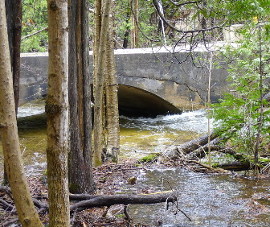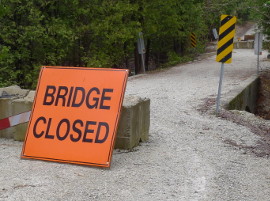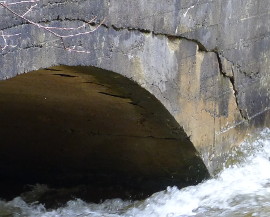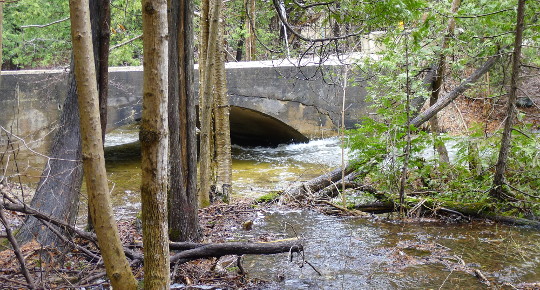Stephen Vance, Staff

If you drive along the 2nd Concession South between Bognor and Walter’s Falls, and make a left turn onto the gravel-topped Holland-Sydenham Town Line, you’ll travel a winding road, surrounded by trees and agricultural land. Along the route you’ll pass just four driveways to residential properties. The drive is enjoyable and relaxing, but you won’t be able to travel the full length of the road, which would bring you to Grey Road 29 if not for a closed bridge. Two bridges to be precise, one immediately after the other, and both having reached the end of their useful lives.
The dilemma faced by Meaford’s council is what to do about these two concrete bridges that traverse the creek and provide an important, level route out of the valley for local residents and farmers.

In September of 2016, the municipality hired consulting firm Planmac Engineering Inc. to complete a Municipal Class Environmental Assessment (MCEA) for the bridges, and in their report presented to council on April 10, they came to the same conclusion as the SOTI report a year earlier – that the bridges, which have been closed for more than a year, should be removed permanently, and that recommendation has area residents frustrated.
“The structures are quite aged. They are older than 70 years and have heavy swelling and cracking,” Mike Neumann of Planmac told council when presenting the environmental assessment report. “The structures are in poor condition, and they are continuing to deteriorate.”

Neumann noted that, according to a traffic study conducted the summer before the bridges were closed, the road sees an average of just 29 vehicles per day pass through. The majority of those vehicles would be residents of the road itself, and local farmers who can easily navigate the flat gravel road that is surrounded by otherwise hilly terrain.
The estimated cost to replace the bridges ranges from a low of $750,000 to $1.2 million for a corrugated steel plate culvert structure, to as much as $2.4 million for a cast in place or precast concrete culvert structure.
Last year the bridges, referred to by the municipality as bridges 021 and 022, were included on a list of eight of Meaford’s 80 bridges that should or could be closed as part of an overall strategy for addressing the more than $80 million that Meaford will need to spend on its bridge infrastructure over the next 50 years.
“The state of the Municipality’s bridges and culverts is declining,” council was told in May of last year when the State of the Infrastructure (SOTI) report for bridge was presented. That report determined that the current value of the Municipality’s bridge and culvert structures is $53,300,000 and the replacement value of these structures is $80,000,000. (Both of these numbers were determined in 2015 dollars.)
In June of last year, a month after receiving the SOTI report, council adopted a strategy that will see the municipality spend nearly $80 million on bridges over the next 51 years, an average of $1.5 million per year.
Those who regularly used bridges 021 and 022 want council to replace the bridges in spite of the findings of the MCEA and SOTI reports.
“There are many reasons for these bridges to remain open. We access many hundreds of acres east of the closure to maintain feed for our dairy herd,” one local farmer told council on April 10. “I feel that this is a unique situation in that the Town-Line road is the only level way out of the valley. Concession 2 Meaford and Concession 10 Chatsworth are definitely not safe alternative routes for our families, employees, supply companies, or whoever else uses that safe route out. There are also two working dairy farms west of us that share the same concerns. These alternative routes are not acceptable for moving feed for our cows, planting and harvesting our crops, or just trying to get to Grey Road 29.”
That there are alternate routes that can be taken is of little comfort to area residents. The detour routes are lengthy, particularly for slow-moving farm vehicles, and hills make the detours a challenge. The northern detour is roughly 3.2 kilometres long, and takes four minutes to travel in a standard vehicle in ideal weather conditions. The southern detour is roughly 2.4 kilometres, and takes approximately three minutes driving time. Residents told council that the steep hills cause safety concerns for the slow-moving farm vehicles, especially in the winter months.
Several other residents of the area who attended the April 10 council meeting agreed that council should opt to replace the bridges, however Meaford’s Treasurer, Darcy Chapman, warned that deciding to ignore the recommendation of the MCEA study and replacing the bridges could set a precedent for future decisions on bridge closures.
“This is unfortunately at this stage of the game a precedent-setting decision for council, and for this municipality moving forward,” Chapman told council on April 10. “If we decide not to replace the bridges, we stay on the course of trying to come up with $1.5 million annually (for the next 50 years). If we decide to keep these bridges and replace them, we might as well say that the other seven structures (previously identified as bridges that should be closed) are now going to fall into that same category. The bridge state of the infrastructure report suggests that those eight structures combined would cost $13 million. So what we can do is add $266,000 per year to that 50 year plan, effectively adding starting next year, a two percent increase to the tax base that stays for the next 50 years in order to replace these other eight structures. So it is a huge, precedent-setting decision.”
The Treasurer also reminded council that future bridge infrastructure decisions could be even tougher than bridges 021 and 022 given that 11 bridges that will require rehabilitation or replacement in the coming years feed dead end roads, and nine of those 11 bridges lead to just one property.
“Those are going to be the really tough ones because how do you justify spending a million and a half dollars on a bridge that has a traffic count of two because the vehicle goes in in the morning and comes back at night and it serves just one residential property?” Chapman asked council.
For their part, members of council appeared torn about what to do about the bridges in spite of the fact that last year they voted in favour of closing them permanently. Deputy Mayor Harley Greenfield suggested that council has an obligation to replace the bridges due to the amalgamation restructuring agreement between the former Town of Meaford and the Townships of St. Vincent and Sydenham that promised service levels in the rural areas would remain the same as prior to amalgamation, while other members of council expressed concern about the closure of the bridges having a negative impact on area farmers.
“What concerns me is the fact that we’re an agricultural community, agriculture is our number one industry here, and I feel that it’s important to give this major consideration because it’s the first time we’ve been presented with a decision to make in terms of bridges, and we’ve got others to look at and this sets a little bit of a precedent in terms of how we approach these circumstances,” Councillor Shirley Keaveney said at the April 10 meeting. “I recognize that the use is fairly minor, 30 vehicles per day you suggest, but looking at the impact on the farmers, and the fact of them having to go out and drive around. It’s dangerous in my unlearned opinion.”
Meaford isn’t alone in facing these infrastructure challenges. Many municipalities across North America have had to close lesser-used bridges in order to ensure that limited resources are directed to the most pressing and most used pieces of bridge infrastructure. The challenge for Meaford’s council is to balance the level of impact on the community with the recommendation of the MCEA report, and responsible spending of municipal dollars.
Perhaps council’s biggest challenge is that there are 80 bridges in the municipality, and as the years move on, each and every one of them will require a significant investment in order to rehabilitate or replace them. Some, like the ‘bake shop’ bridge on Edwin Street, which will see some rehabilitative work done this coming summer, carry more than 500 vehicles per day and are crucial to maintaining traffic flow in the urban area, while others like bridges 021 and 022 put council in the difficult position of deciding if funding a replacement can be justified given low use and limited resources.
Those realities do little to soothe the frustrations of those that have relied on bridges 021 and 022 for safe, time-efficient travel to and from their homes and farms.
The infrastructure nightmare that we’ve been warned about for several years begins.












